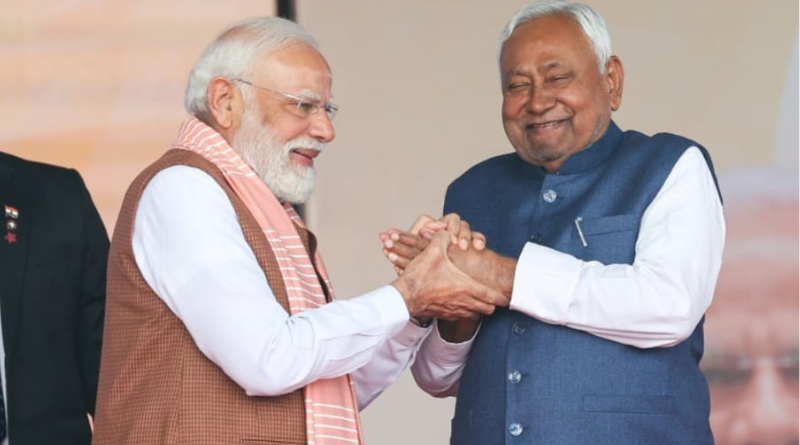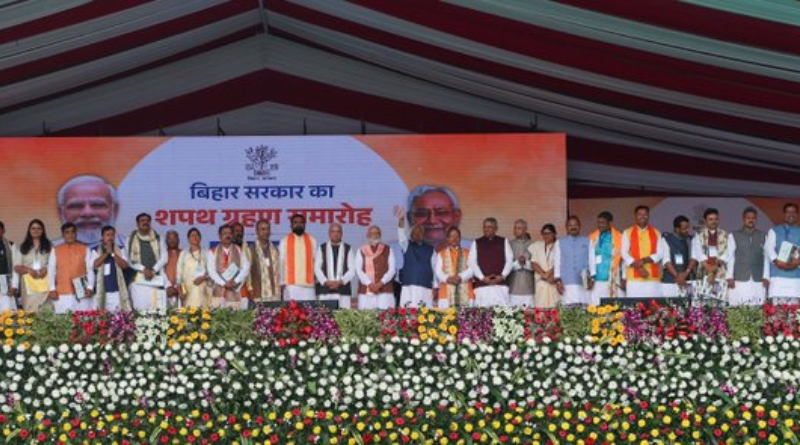The Nitish Kumar cabinet has 26 ministers, giving representation to key castes and religions.
Photo Credit: The Suncity News.

Patna, November 20, 2025: Nitish Kumar was sworn in as Chief Minister of Bihar along with 26 ministers who represent every section of society.
The cabinet includes 14 ministers from the BJP, 8 from the JDU, 2 from LJPRV, one from RLM and 1 from HAM.
Nitish Kumar has given a political message through his vast cabinet representation:
In this cabinet, the BJP has notably reduced its Brahmin representation compared to the previous government.
Earlier, Mangal Pandey and Nitish Mishra represented the Brahmin community.
This time, the BJP has excluded Nitish Mishra, though Mangal Pandey has been retained.

The BJP has instead strengthened the Rajput representation by inducting four leaders from the community, including Sanjay Tiger, Shreyasi Singh, Leshi Singh, and Sanjay Singh.
The party aims to consolidate its traditional Rajput vote bank.
Nitin Naveen, a prominent Kayastha face with influence in Patna and urban areas, has also been included by the BJP.
The JDU, on the other hand, has not inducted any Brahmin MLAs into the cabinet this time.
Bhumihar, OBC and Yadav representation in the Nitish Kumar government:
From the influential Bhumihar community, Vijay Kumar Sinha and Vijay Kumar Choudhary have been appointed as ministers.

Their inclusion reflects the NDA’s attempt to maintain caste balance, as Bhumihars hold a significant place in Bihar’s political landscape.
Given the importance of OBCs in the state, the Nitish Kumar government has ensured wide representation.
Samrat Choudhary (Deputy CM) and Deepak Prakash have been included from the Kushwaha/Koiri community.
Both carry significant political weight, especially Samrat Choudhary.
From the Yadav community, traditionally aligned with the RJD, Ram Kripal Yadav and Vijendra Prasad Yadav have been included, signaling the NDA’s attempt to appeal to this dominant OBC group as well.
Nitish Kumar’s core base Kurmi community, is represented by Shravan Kumar, while Pramod Kumar represents the Chandravanshi community.
Strong representation of the EBC community:
Recognizing the critical role of Extremely Backward Classes (EBCs) in Bihar politics, the NDA has ensured broad inclusion from multiple EBC castes.
The Nitish Kumar government has given representations to Surendra Mehta (Dhanuk), Rama Nishad (Nishad/Mallah), Madan Sahani (Mallah), Lakhendra Kumar Roshan (Paswan), Sunil Kumar (Ravidas), Santosh Kumar Suman (Manjhi), and Sanjay Kumar (Paswan).
Their presence underscores the NDA’s strategy to retain its strong support among EBCs, who form one of the biggest pillars of the coalition’s social base.
The Nitish Kumar government has also inducted Mohammad Jama Khan into the cabinet. The NDA has also taken a symbolic yet significant step toward projecting the government as inclusive and socially balanced.
This move aims to send a positive message to Bihar’s Muslim community.
Also Read: Nitish Kumar made a record, sworn in 10th time as Chief Minister of Bihar.
EOM.
Pingback: The RJD said the NDA has hypocritical stance over nepotism, as 9 ministers sworn in have political family backgrounds.